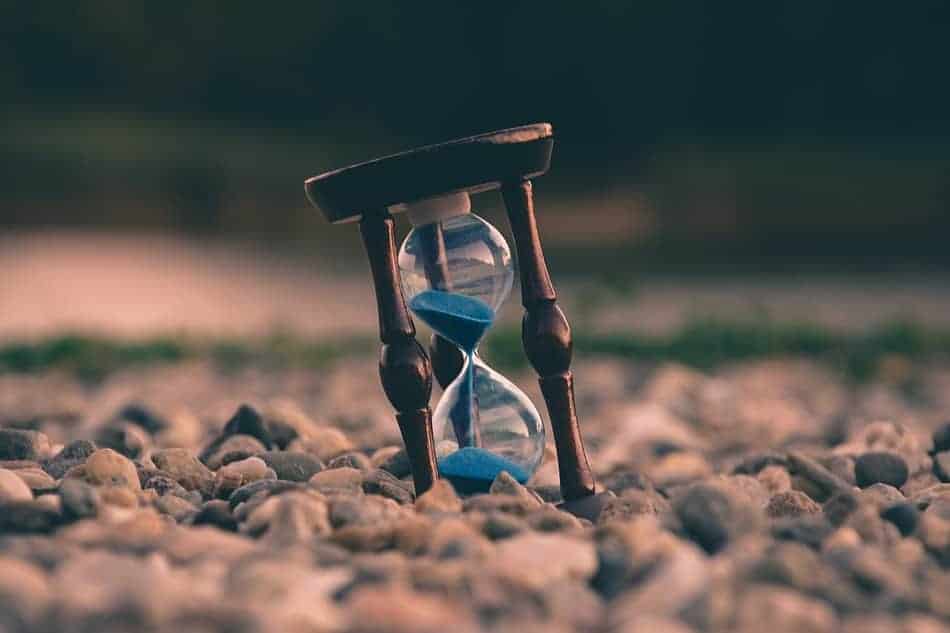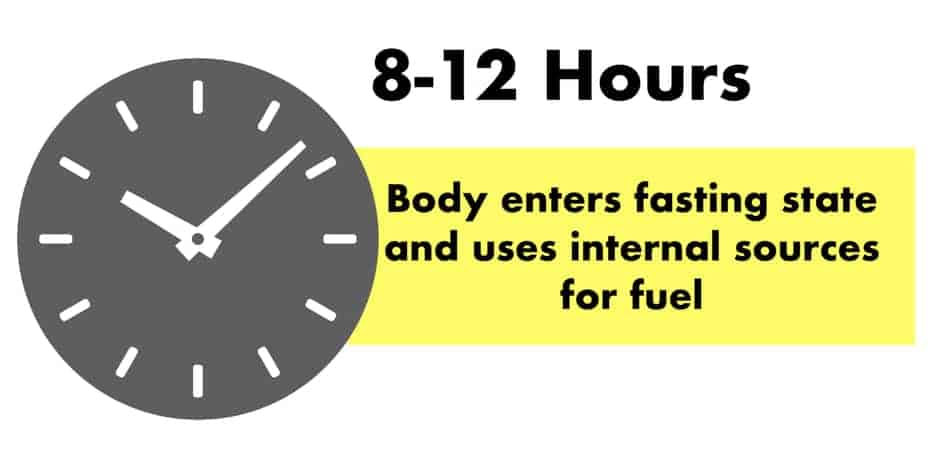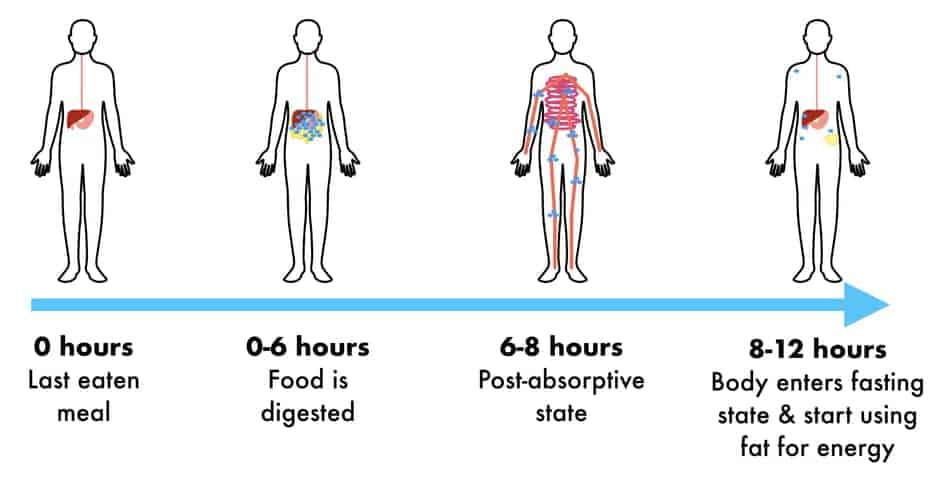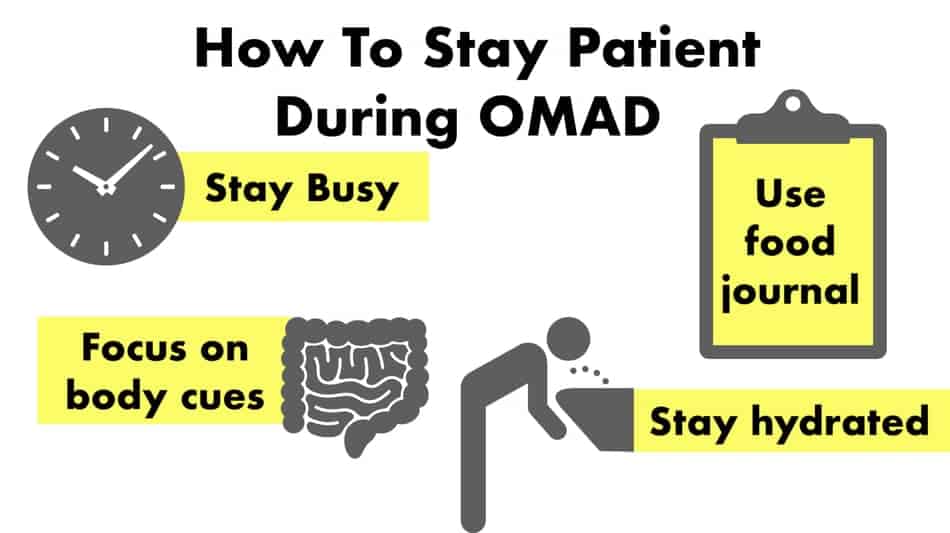
The first time I was doing OMAD, I was curious to see how long it takes to work. I remember being very impatient because I wanted to know when I will start seeing the results. And after doing OMAD for over a month this is what I’ve found out.
In general, OMAD takes around 5-7 days to work. In the first week, the body response by eliminating excess water due to less carbohydrate intake. In the second and third weeks, your body enters into ketosis, and that’s when you start to use fat as fuel.
Normally it should take around 8-12 hours from your last meal to start using store fat as fuel. But it’s not one size fits all. Here’s what you need to know.
When Do You Start Seeing Results On OMAD?
You start seeing the results in the first two weeks on OMAD. However, 12 hours after your last meal, the body enters into ketosis, where it switches from using glucose from food to body fat as energy. So when you’re doing one meal a day, the process literally begins on day one.
But it will take time to notice any visual difference.

So in the first few weeks, don’t worry about the actual results. You cannot control the outcome, yet.
Instead, think about what you can control. Make sure your actions match your goals. This means you need to stay hydrated, sleep well, stay active, get busy and remove all the unnecessary food that will be tempting you to break a fast.
- Focus on one day at a time. If you target your goals down to a single day, it is much more in your control.
- Shrink the goal down. If your goal is to lose 50 lb this year, this may overwhelm you. Instead, focus on how you can lose 1-2.5 lb this week.
What actions do you need to take to make it happen? Because the truth is, if you already lost 2 lb this week, you can easily do it again next week.
- Makeover your kitchen. This means that if you will keep the healthy food accessible and remove all the trigger food that you know will cause unwanted behaviors. The truth is that if the food is in your house or your possession, sooner or later, you will eat it.
This works both ways. So if you stuck up your pantry and your fridge with healthy options. So even if you will feel like you are about to break the fast, you have healthy options available.
Here you can see in the picture the timeframe what happens with your last meal to when OMAD starts to work.

During the fasting time, your body starts to switch the source of energy from external (food) into internal (fatty acids, glycogen, and much later, protein) (source).
To help you understand how this works, let me show you a timeline of what happens with your body from the moment you have your last meal to the actual fat burning phase.
The food we eat is composed of a wide range of nutrients. Some are known, some are unknown. The most well known are macronutrients (proteins, fats, carbohydrates) and micronutrients (vitamins, minerals, water, and phytonutrients).
As those nutrients are quite large, they need to be broken down to be able to get absorbed. This takes some time.
And depending on the type of food and food combination you had with your last meal, it will dictate how long it takes to process, and pass it through the general circulation.
0 – 6 Hours After Your Last Meal

This is when your food is being digested. This time is called the post-prandial period. The time after your meal. This also when bile, enzymes, and neuropeptides are released. They are all are helping you to transit the nutrients into the body.
The food isn’t absorbed from your stomach. Only certain alcohol, drugs, water, some vitamins and fatty acids can cross the barrier of your thick stomach and enters the circulation.
The majority of the food enters the small intestines and it travels at the pace of 1 cm per minute. From there all the nutrients are being extracted and passed to the body (source).
6 – 8 Hours After Your Last Meal

The majority of digestion is already done. This stage is called a post-absorptive period. All the nutrients are available and your body is using them for energy, repair, storage, and other metabolic processes.
During this time glucose levels in the blood start to drop, as your cells use it for energy. This means your body is starting to rely on stored glycogen from your muscles and liver (source).
8- 12 Hours After Your Last Meal

Now your body already used all the nutrients form your last meal, this means we are entering into the fasted state. Somewhere in this timeframe your body is switching in energy and nutrients supply from “external sources” (aka food) into “internal sources” (aka stored energy).
Here glucose levels in the blood are very low so the body switches into using glycogen.
Because your blood sugar levels have to be balanced, now you see many hormonal changes doing on. Your insulin levels drop and your glucagon levels raises. This way your stored glycogen is pushed back into the blood to fuel the tank for your energy (source).
12- 48 Hours After Your Last Meal

Here your body continues to release glycogen from the liver. The supply can last up to 24-hours, depending on how physically active you are.
At this stage, your body starts to break down the fatty acids to help to shuttle more energy. Fatty acids break down and deliver glycerol. The process is called gluconeogenesis, and it takes place in the liver and kidneys (source).
This process is only available in the absence of carbohydrates. Because your body runs out of glucose, now is the time to create ketone bodies as primary energy for the brain.
This is where you may notice that your breath starts to “smell”. And your urine, too. This is the side effect when you are in full ketosis. When your body produces ketone bodies, it will produce also a waste product, like acetone (source).
This is normal. Your body manufacture acetone everyday. But ketosis just multiply this process.
For me personally, it doesn’t feel comfortable at all. But breath acetone is as good a predictor of ketosis. So once you notice the changes, you know you’re on the right track.
48- 72 Hours After Your Last Meal

If you’re in the fasted state longer than 48-hours your body starts to down-regulate to help maintain the key physiological processes. How significantly and how much you will experience those changes, and whether they are helpful or harmful, will depend on many factors.
How much energy you have stored in your body fat, how long you’ve fasted already, how active you are, how stressed you’re, etc. Those factors will impact (positively or negatively) the physiological changes (source).
Your circulating blood sugar is decreasing, as well as your metabolic rate and protein synthesis. Also your gastrointestinal mobility, and blood pressure.
On the other hand, you have an increase in circulating ketone bodies, circulating fatty acids, and insulin sensitivity.
At this point, the body almost exclusively depends on the fatty acids released from the adipose tissue (stored body fat) for fuel.
How To Stay Patient During OMAD?
To stay patient on OMAD, focus on behaviors instead of outcomes. Outcomes are out of your control, but you can control the behavior. Keep yourself busy, focus on body cues, stay hydrated, and use a food journal to capture thoughts and emotions.
I remember being very impatient to know when I will start seeing the results. And I would step on my scale each morning, wondering will it change.

I felt that my waist is getting smaller. And when I tightened my belly muscles, I could feel it getting slimmer.
But the reality is that even if you fast for 20-24 hours, and your body is already using fat for energy, you won’t be able to see that on the scale on day one. So how to stay patient? Here are some of my best tips.
Tip #1: Stay busy during the day
Keep yourself busy. You don’t want to find yourself being bored, because that can trick you into comfort food. Surround yourself with some low-grade responsibilities that don’t need a lot of thinking, like cleaning or gardening.
Tip #2: Focus on the body cues
OMAD is a great way to learn something new about yourself. You will notice how your body reacts to lack of food, what type of emotions and feelings you have, how is your cognition, energy, and productivity level.
Those are all great messages that will tell you is this practice good for you. And just because you may be losing weight, but as the result, you feel like your life is falling apart, this may be a great indicator this approach is not for you.
Tip #3: Use food journal
This is a great opportunity to capture all those moments, thoughts, feelings and emotions that comes along. You can start to tune in to your body and discover how does real hunger feels.
So using the food journal will help you to keep track of how your body feels. Just because you feel ok on day one doesn’t mean you will feel the same 2 weeks later.
Tip #4: Stay hydrated
Do not skip that part. You will be losing a lot of water and electrolytes. So you don’t want to get dehydrated. It can ruin your energy, and mood and you are more likely to break the fast feeling frustrated and exhausted.
Apart from drinking water, I also like to drink coffee (no sugar) with high caffeine. My favorite one is from Shock Coffee available on Amazon. Details here.
(if you buy through links on this page, I may earn a small commission).
Also, try to avoid any alcohol consumption. Alcohol will likely stop any fat-burning process and may jeopardize your results.
Take Away
As you can see, fasting starts to work within the first few hours after your last meal. Your body switch from outside sources into inside sources of energy. So it really works on day one.
Those changes do happen, but they are just not big enough for you to see immediate results. Slow and steady wins the race.
Think of your nails and hair as they grow. You can’t see a huge difference on a day-to-day basis. But once you wait for a week or two, those changes add up. And the accumulation is much more “visible”.
So patience is the key here. This process works and it just needs time. If you’re eating just one meal a day there is not way you cannot lose weight.
Many times you may feel like you want the results to happen immediately. And that’s normal. I was impatient too.
Go Further with OMAD
This article is part of the Doing OMAD But Not Losing Weight
In the following pages, I show you all the related aspects necessary to troubleshoot all the reasons why OMAD may not work and what you can do about it.
Next: Click here to learn more about why am I gaining weight on omad
